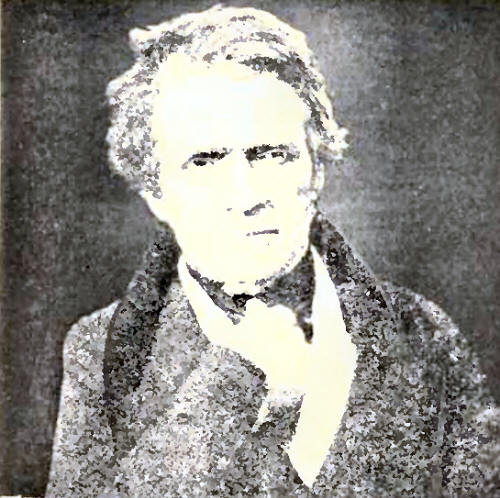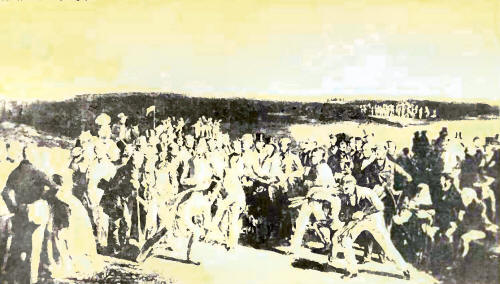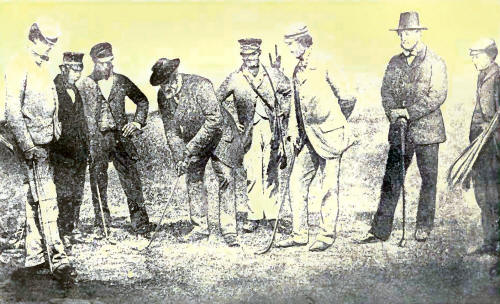|
TOM'S occupation in Allan
Robertson's shop was entirely that of ball-making. The making of the old "featheries"
was a somewhat arduous task. They were made, as everyone who knows anything
about the history of the making of golf balls is aware, by taking a lot of
feathers it is said "a him hat" held about the quantity sufficient for
making a ball and compressing them, handful after handful, into a little
pocket of bull's hide, cured with alum.
"You were just like a kind o' shoemaker," said Tom to me lately, speaking of
those far-off days, "for after you had filled them as far as the pocket
could hold, pressed into as small a compass as possible, you had to sew
them."
The shape thus assumed by the full and sewed-up pocket was more like an egg
than the round sphere we are accustomed to associate with golf balls. They
were by no means perfectly round. The feathers were obtained chiefly from
farmyard poultry. A good workman could make about four feather balls in a
day.
Of course, Tom would often have to be spared from his work to take part in
matches with gentlemen of the Club who consulted Allan about a partner in a
foursome, and also for the playing of single matches. And every now and
again he would be matched either with or against Allan and some brother
professionals. A very charming life in many ways it would be. He would get
plenty of healthful exercise and pleasant recreation in the game he loved,
and of which he was rapidly becoming such a first-class exponent. He "doesna
mind" much about his earliest matches. But among the gentlemen he played
with alone or along with Allan, there would be, besides the famous quartette
I mentioned in the previous chapter, Colonel Oliphant of Rossie, grandfather
of the late Mr T. T. Oliphant a family related collaterally at least to the
Baroness Nairne, to Laurence Oliphant, and even to Mrs Oliphant, the
distinguished novelist and most versatile and industrious of writers.
Colonel Oliphant lived in St Andrews for a long time. Here is how Carnegie
speaks of him:
"But where is Oliphant, that
artist grand?
He scarce appears among the golfing hand.
No doubt he's married; but when that befalls,
Is there an end to putters, clubs and balls?"
And, again, had they known
the game:
"Mars, Jove, and Neptune would
have studied golf,
And swiped like Oliphant and Wod below,
Smack over Hell at one immortal go!"
Then there is Mr Craigie
Halkett:
"One who can
Swipe out, for distance, against any man.
But in what course the ball so struck may go
No looker-on not he himself can know."
And Major Holcroft:
"He's a steady hand
Among the best of all the golfing band;
He plays a winning game in every part
But near the hole displays the greatest art."
And Captain Cheapo:
"A sailor by profession,
But not so good at golf ;is navigation."
Then there was the French
teacher, Mr Messieux, at the Madras College, whose feats in long driving are
still remembered on the links:
"A noble player,
But something nervous, that's a bad affair,
It sadly spoils his putting, when he's press'd,
But let him be and he will beat the best"
Then there was Dr Moodie, a
well-known medical practitioner in St Andrews, a stout little man with a
face and complexion rightly or wrongly associated with the colour of port
wine:
"There Dr Moodie, turtle-like,
displays
His well-filled paunch, and swipes beyond all praise,
While Cuttkhill, of slang and chatter chief,
Provokes the bile of Captain George Moncrieffe."
"Cuttlehill" was Mr James
Wemyss of Cuttlehill, known as "Flash Jim." He was laird of Cuttlehill near
Dunfermline. He ran through his estate in early years, and resided for a
considerable time at No. 3 Bell Street, St Andrews.
Carnegie thus writes of him:
"But Cuttlehill, that
wonderful buffoon.
We meet him now no more, as wont, at noon;
No more along the green his jokes are heard,
And some who dared not then, now take the word.
Farewell! facetious Jem too surely gone
A loss to us Joe Miller to Boulogne."
Of the other early players of
those days we shall get a good idea by reading what Carnegie says of them as
depicted in the old golfing picture, entitled "The Finish of a Big Match,"
which we reproduce as an illustration. It is from a painting by Mr Charles
Lees, R.S.A., engraved by C. E. Wagstaffe. The scene is at "the Ginger Beer"
the fifteenth hole where matches in the old days used often to end and
luncheon was taken. The figure of the tall man bending forward to see the
fate of the ball is that of Sir David Baird, Bart., of Newbyth, whose
acquaintance we have already made, and who, as Carnegie wrote:
"Can play
With any goiter of the present day."
Next to him, also with a tall
hat, is the one who has evidently just made his putt. It is Major,
afterwards to become Sir, Hugh Lyon-Playfair.
"That's Major Playfair, man of
nerve unshaken,
He knows a thing or two or I'm mistaken;
And when he's pressed, can play a tearing game,
He works for certainty, and not for Fame!
There's none, I'll back the assertion with a wager,
Can play the heazy iron like the Major."
He was "a star at golf" and
"skilled in many a curious" art
"As chemist, mechanist, can
play his part,
And understands besides the power of swiping,
Electro Talbot and Daguerreotyping."
The little man with bent
knees, and eyes so closely watching the progress of the ball, is Mr Thomas
Patton, of Glenalmond, the first of "The Mushrooms" named by Carnegie in
"Another Peep at the Links:"
"Now lor the mushrooms, old
perchance or new,
But whom my former strain did not review;
I'll name an old one, Patton, Tom of Perth,
Short, stout, grey-headed, but of sterling worth;
A golfer perfect, something it may be
The worse for wear, but few so true as he;
Good-humour'd when behind, as when ahead,
And drinks like blazes till he goes to bed."
It was a match in which Tom
Patton was engaged that gave rise to a famous contest between Allan
Robertson and James Condie. Condie and Patton had obtained a handsome
victory over Allan and Sir John Mackenzie. At dinner, alter the match was
over, Mr Condie teased Allan about having a lot of good clubs with a poor
player behind them. The result of this chaff was that Mr Condie and Allan
betted clubs against each other for another round of the links. Let Mr Peter
Baxter tell its story, as given in his excellent and compact little book on
Golf in Perth and Perthshire. "Mr Condie was a great humorist, and
completely put Allan off his usual game. The result was that Allan no sooner
won back a club than he would lose two holes in succession, which caused the
club to be again handed over to Mr Condie's caddie, and another along with
it. Allan had rather a rueful countenance as the finish of the Perth course
came into view. On driving to the last hole Allan had only his driver and
his putter left. Had he been able to win he would have redeemed his iron,
but instead he lost and his driver was claimed. Mr Condie insisted on Allan
showing what he could do with his putter alone, and an extra hole out and
back was played. Condie won the putter!' Surely you'll let me take one club
home? ' pleaded Allan. 'No,' replied Mr Condie, and Allan's clubs remained
in Perth, at least for one night."

Samuel Mesieux (who drove a ball 380 yards)
The last of the four players, drawing back his figure as if he would keep
the ball from going into the hole, is Sir Ralph Anstruther, Bart., of
Balcaskie.
"Sir Ralph returns he has been
absent long
No less renown'd in golfing than in song;
With Continental learning richly stored,
Teutonic Bards translated and explored
A Literaire a German scholar now,
With all Grischia's honours on his brow!
The little caddie jumping
with delight is Willie Pirie, and the tall one strenuously leaning forward
is Sandy Pine, about both of whom I shall have something to say in my book
on Caddies.

An exciting finish
There does not seem to be any indication as to who are the two men, whose
heads and shoulders we only see, bending down behind Tom Patton. But
immediately behind him is Colonel Murray Belches, of Invermay, who is
commemorated to the present day in the handsome silver cross which is the
first prize at the May Meeting of the Royal and Ancient Club. A little
behind him and to the right, with bare head and hat in hand, is Mr James H.
Dundas, W.S., and still further to the right and behind Dundas are Mr James
Blackwood and Mr James Oliphant, W.S. Still further to the right, with the
tall hat, is Sir N. H. Lockhart, Bart., Carnwarth, and behind him Mr Charles
Robertson ("Cowling" Charlie). A little to the right in a group of six is
John Campbell of Glensaddell, of whom we have heard, and at his shoulder,
bareheaded, is Dr Henry Macfarlane, Perth, "The Young Doctor," as he was
called. By Saddell's left shoulder, also uncovered, is Sir John Campbell of
Aird. Behind him is Col. Moncrieife, subsequently "The General," and Robert
Chambers, the famous publisher.
"Still George Moncrieffe
appears the crowd beiore,
Lieutenant-Colonel Captain now no more;
Improv'd in everything, in looks and life,
And, more than all, the husband of a wife."
Colonel George Moncrieffe was
the nephew of old Mrs Cheape, of Strathtyrum (Helen Moncrieffe), and lived
much there. On leaving the Army he settled in St Andrews and lived at The
Priory. In my early days he was known as General Moncrieffe, and was Provost
of the city. He was the father of the popular General Moncrieffe, whom I
lately saw at Sunningdale during the competitions for the News of the World
prizes, looking not one day older than he did in the old St Andrews days;
and of Mrs Curwen and Mrs Harriot, one of his twin daughters. The Priory,
under the benignant sway of this well-known St Andrews family, was ever a
centre of hospitality and kindness. The General was prominent as a citizen
and as a member of the Club, though what Carnegie calls his choleric "bile"
was sometimes in evidence.
The tall farthest back figure with the tall hat is Lord Viscount Valentia.
The little girl is a seller of ginger-beer. Taking the glass from her is the
Hon. Henry Coventry. Sitting beside him, leaning on his staff, is George
Cheape of Wellfield. Looking over Mr Cheape's head is Willie Dunn, the golf
club-maker, Musselburgh, destined to be one of Tom Morris's opponents. The
big man in the tall hat behind him a little to the left is Mr W. Wood,
Leith.
"Still portly William Wood is
to be seen,
As good as ever on the velvet green.
The same unfailing trump."
To his left a little, club in
hand, is Captain David Campbell. Behind him to the right is Mr W. Peddie of
Black Ruthven. Patton's ("Tom of Perth")
"friend is Peddie, not an
awful swiper,
But, at the putting, he's a very viper;
Give him a man to drive him through the green
And he'll be bad to beat, it will be seen.
Patton and Peddie, Peddie and Patton,
Are just the people one should bet upon."
Next to him and almost behind
Mr Wood is Mr George Dempster of Skibo; then Mr Goddard of Leith, and the
figure to the extreme right at the back is Mr Robert Patullo of Balhouffie,
a small proprietor near Anstruther. He lived in Balfour House in North
Street, and was a great "habitue" of the links:
"There young Patullo stands,
and he, methinks,
Can drive the longest ball upon the links,
And well he plays the spoon and iron, but
He fails a little when he comes to putt."
Again:
"And good Patullo! he who
drove as none,
Since him, have driven he is also gone!
And Captain Cheape, who does not mourn the day
That snatch'd so good, so kind a friend away!"
This exhausts those members
of the group on the right hand of the foursome. In the distance a match is
seen coming in. That there must be some good players in it may be inferred
from the fact that it seems to have a considerable following. To the left of
the picture St Andrews is seen in the distance. Of the group in the
foreground to the extreme left is Sir John Muir Mackenzie of Delvine, Bart.,
and Sir John Murray Macgregor, Bart. The third member of the little group
with the two ladies is Mr Tyndall Bruce of Falkland. He is looking
"sideways" at the holing out. Sir Charles Shaw is standing far back, just
beside the head of the horse which is ridden by a lady. Next to him, with a
tall white hat, is Colonel Playfair, of St Andrews.
"See Colonel Playfair, shaped
in form rotund,
Parade the unrivall'd Falstaff of the ground;
He laughs and jokes, plays 'what you like,' and yet,
You'll rarely find him make a foolish bet."
The tall, good-looking man in
front of him, bareheaded, is the Earl of Eglintoun. Behind him the head only
of Mr Robert Lindsay of Straiton can be seen. "Old Robert Lindsay" was the
younger brother of the Earl Lindsay of Balcarres. He lived many years in the
"east-most house" in South Street, St Andrews.
"Old Robert Lindsay plays a
decent game,
Tho' not a golfer of enormous fame.
Well can he fish with minnow as with fly.
Paint, and play farthing-brag uncommonly.
Give jolly dinners, justice courts attend,
A good companion and a steady friend."
Behind him again, with the
tall hat, is Mr James Hay of Leith. Bending down, a little more in the
foreground, is the Earl of Leven and Melville. The figure behind and next to
him is unmistakable. It is Allan Robertson. Right behind him, with the tall
hat, is the well-known Sheriff Gordon, a great humorist in his day, whose
wife was a daughter of Christopher North. To his right are John Sligo of
Carmyle and Hamilton Anstruther. In the nearer foreground but behind, a
little to the right of Allan, is Mr John Whyte Melville.
"There, to the left, I see
Mount Melville stand
Erect, his driving putter in his hand.
It is a club he cannot leave behind,
It works the balls so well against the wind."
And again:
"Mount Melville still erect as
ever stands,
And plies his club with energetic hands;
Plays short and steady, often is a winner,
A better Captain never graced a dinner."
The head without the hat is
that of Lord Berridale, and to the right and behind him are Mr F. Blair of
Balthayock, and the Master of Strathallan. The figure to the left of Sir
Hugh Lyon-Playfair is that of John Grant of Kilgraston.
"But for John Grant, a clever
fellow too,
I really fear that golf will never do!
Tis strange indeed, for he can paint and ride,
And hunt the hounds, and many a thing beside;
Amuse his friends with anecdote and fun;
But when he takes his club in hand he's done '
Stay! I retract! Since writing the above,
I've seen him play a better game, by Jove;
So much beyond what one could have believ'd,
That I confess myself for once deceived.
And if he can go on the season through,
There's still a chance that he may really do."
To the right of him, without
his hat, is Mr J. Wolfe Murray of Cringlctic.
"Next comes a handsome man
with Roman nose,
And whiskers dark Wolfe Murray, I suppose.
He has begun but lately, still he plays
A lairish game, and therefore merits praise;
Ask him when at his worst, and he will say,
'Tis bad, but Lord! how I play'd yesterday!'
Mr Wolfe Murray was long
about St Andrews as a bachelor. He married the younger daughter of Mr Whyte
Melville.
Next to him, tall hat in hand, is Colonel Ogilvie Fairlie of Coodham, a
line-looking man, a splendid golfer and a great patron of Tom Morris. He was
the brother-in-law of "Saddell," and often lived with him at The Priory.
"I've kept a man, in petto,
for the last
Not an old golfer, but by few surpassed
Great Captain Fairlie! When he drives a ball
One of the hcsf, for he don't hit them all,
It then requires no common stretch of .sight
To watch its progress and to see it light."
Behind him is Mr John Hay of
Morton, and underneath him to the right is John Balfour of Balbirnie, a
large landed proprietor in File, and prominent business man in the county,
which he contested for a seat in Parliament. He was Master of the Hounds,
and a great golfer.
"Balbirnie and Makgill will
both be good,
Strong, active, lathy fellows; so they should."
George Makgill is not in the
picture. He was a nephew of Sir Hugh Lyon-Playfair. He was much about the
links and was a fine type of a country gentleman.
Behind Mr Balfour is the Hon. David Murray. Then come John Stirling, St
Andrews; James Condie of Perth; and so back to Col. Murray, Belches.

Tom Morris, Allan Robertson and others |
